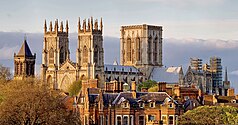North Yorkshire
North Yorkshire | |
|---|---|
|
Top to bottom, left to right:
Ribblehead Viaduct in the Yorkshire Dales, the Tees Transporter Bridge in Middlesbrough, Staithes, and York Minster
| |
 Location of North Yorkshire within England
| |
| Coordinates: 54°10′N 1°20′W | |
| Sovereign state | United Kingdom |
| Constituent country | England |
| Region | Yorkshire and the Humber and North East |
| Established | 1974 |
| Established by | Local Government Act 1972 |
| Origin | Yorkshire |
| Time zone | UTC±00:00 (Greenwich Mean Time) |
| • Summer (DST) | UTC+01:00 (British Summer Time) |
| Members of Parliament | List of MPs |
| Police |
North Yorkshire Police Cleveland Police |
| Largest town | Middlesbrough |
| Ceremonial county | |
| Lord Lieutenant | Johanna Ropner |
| High Sheriff | Clare Deborah Granger (2023–24) |
| Area | 9,020 km2 (3,480 sq mi) |
| • Ranked | 1st of 48 |
| Population (2021) | 1,158,816 |
| • Ranked | 14th of 48 |
| Density | 134/km2 (350/sq mi) |
| Ethnicity |
|
| Districts | |
 Districts of North Yorkshire | |
| Districts |
Unitary: |
North Yorkshire is a ceremonial county in the Yorkshire and the Humber and North East regions of England. It borders County Durham to the north, the North Sea to the east, the East Riding of Yorkshire to the south-east, South Yorkshire to the south, West Yorkshire to the south-west, and Cumbria and Lancashire to the west. Northallerton is the county town.
The county is the largest in England by land area, at 9,020 km2 (3,480 sq mi), and has a population of 1,158,816. The largest settlements are Middlesbrough (174,700) in the north-east and the city of York (152,841) in the south. Middlesbrough is part of the Teesside built-up area, which extends into County Durham and has a total population of 376,663. The remainder of the county is rural, and the largest towns are Harrogate (73,576) and Scarborough (61,749). For local government purposes the county comprises four unitary authority areas — York, Middlesbrough, Redcar and Cleveland, and North Yorkshire — and part of a fifth, Stockton-on-Tees.
The centre of the county contains a wide plain, called the Vale of Mowbray in the north and Vale of York in the south. The North York Moors lie to the east, and south of them the Vale of Pickering is separated from the main plain by the Howardian Hills. The west of the county contains the Yorkshire Dales, an extensive upland area which contains the source of the River Ouse/Ure and many of its tributaries, which together drain most of the county. The Dales also contain the county's highest point, Whernside, at 2,415 feet (736 m).
History
North Yorkshire non-metropolitan and ceremonial county was formed on 1 April 1974 as a result of the Local Government Act 1972. It covered most of the North Riding of Yorkshire, as well as northern parts of the West Riding of Yorkshire, northern and eastern East Riding of Yorkshire and the former county borough of York. Northallerton, as the former county town for the North Riding, became North Yorkshire's county town. In 1993 the county was placed wholly within the Yorkshire and the Humber region.
Some areas which were part of the former North Riding were in the county of Cleveland for twenty-two years (from 1974 to 1996) and were placed in the North East region from 1993. On 1 April 1996, these areas (Middlesbrough, Redcar and Cleveland and Stockton borough south of the River Tees) became part of the ceremonial county as separate unitary authorities. These areas remain within the North East England region.
Also on 1 April 1996, the City of York non-metropolitan district and parts of the non-metropolitan county (Haxby and nearby rural areas) became the City of York unitary authority.
On 1 April 2023, the non-metropolitan county became a unitary authority. This abolished eight councils and extended the powers of the county council to act as a district council.
Geography

The geology of North Yorkshire is closely reflected in its landscape. Within the county are the North York Moors and most of the Yorkshire Dales, two of eleven areas in England and Wales to be designated national parks. Between the North York Moors in the east and the Pennine Hills. The highest point is Whernside, on the Cumbrian border, at 2,415 feet (736 m). A distinctive hill to the far north east of the county is Roseberry Topping.
North Yorkshire contains several major rivers. The River Tees is the most northerly, forming part of the border between North Yorkshire and County Durham in its lower reaches and flowing east through Teesdale before reaching the North Sea near Redcar. The Yorkshire Dales are the source of many of the county's major rivers, including the Aire, Lune, Ribble, Swale, Ure, and Wharfe. The Aire, Swale, and Wharfe are tributaries of the Ure/Ouse, which at 208 km (129 mi) long is the sixth-longest river in the United Kingdom. The river is called the Ure until it meets Ouse Gill beck just below the village of Great Ouseburn, where it becomes the Ouse and flows south before exiting the county near Goole and entering the Humber estuary. The North York Moors are the catchment for an number of rivers: the Leven which flows north into the Tees between Yarm and Ingleby Barwick; the Esk flows east directly into the North Sea at Whitby as well as the Rye (which later becomes the Derwent at Malton) flows south into the River Ouse at Goole.
Urban to rural Green belt
North Yorkshire contains a small section of green belt in the south of the county, just north of Ilkley and Otley along the North and West Yorkshire borders. It extends to the east to cover small communities such as Huby, Kirkby Overblow, and Follifoot before covering the gap between the towns of Harrogate and Knaresborough, helping to keep those towns separate.
The belt adjoins the southernmost part of the Yorkshire Dales National Park, and the Nidderdale AONB. It extends into the western area of Selby district, reaching as far as Tadcaster and Balne. The belt was first drawn up from the 1950s.
The city of York has an independent surrounding belt area affording protections to several outlying settlements such as Haxby and Dunnington, and it too extends into the surrounding districts.
Climate
North Yorkshire has a temperate oceanic climate, like most of the UK. There are large climate variations within the county. The upper Pennines border on a Subarctic climate. The Vale of Mowbray has an almost Semi-arid climate. Overall, with the county being situated in the east, it receives below-average rainfall for the UK. Inside North Yorkshire, the upper Dales of the Pennines are one of the wettest parts of England, where in contrast the driest parts of the Vale of Mowbray are some of the driest areas in the UK.
Summer temperatures are above average, at 22 °C. Highs can regularly reach up to 28 °C, with over 30 °C reached in heat waves. Winter temperatures are below average, with average lows of 1 °C. Snow and Fog can be expected depending on location. The North York Moors and Pennines have snow lying for an average of between 45 and 75 days per year. Sunshine is most plentiful on the coast, receiving an average of 1.650 hours a year. It reduces further west in the county, with the Pennines receiving 1,250 hours a year.
| Climate data for North Yorkshire | |||||||||||||
|---|---|---|---|---|---|---|---|---|---|---|---|---|---|
| Month | Jan | Feb | Mar | Apr | May | Jun | Jul | Aug | Sep | Oct | Nov | Dec | Year |
| Record high °C (°F) | 15 (59) |
17 (63) |
21 (70) |
24 (75) |
29 (84) |
32 (90) |
40 (104) |
33 (91) |
29 (84) |
28 (82) |
19 (66) |
16 (61) |
40 (104) |
| Mean daily maximum °C (°F) | 6 (43) |
7 (45) |
10 (50) |
13 (55) |
16 (61) |
19 (66) |
22 (72) |
22 (72) |
18 (64) |
14 (57) |
10 (50) |
7 (45) |
14 (57) |
| Mean daily minimum °C (°F) | 1 (34) |
1 (34) |
2 (36) |
4 (39) |
7 (45) |
10 (50) |
12 (54) |
12 (54) |
10 (50) |
7 (45) |
4 (39) |
1 (34) |
6 (43) |
| Record low °C (°F) | −14 (7) |
−10 (14) |
−13 (9) |
−3 (27) |
−1 (30) |
2 (36) |
5 (41) |
4 (39) |
−1 (30) |
−7 (19) |
−14 (7) |
−19 (−2) |
−19 (−2) |
| Average precipitation mm (inches) | 40 (1.6) |
35 (1.4) |
43 (1.7) |
46 (1.8) |
42 (1.7) |
47 (1.9) |
51 (2.0) |
59 (2.3) |
53 (2.1) |
62 (2.4) |
56 (2.2) |
59 (2.3) |
593 (23.3) |
| Source: | |||||||||||||
Governance
Local authorities
| # | Local authority | 2011 census |
|---|---|---|
| – | Ceremonial county | 1,125,547 |
| 1 | North Yorkshire | 598,376 |
| 2 | York | 198,051 |
| 3 | Middlesbrough | 138,412 |
| 4 | Redcar and Cleveland | 135,177 |
| 5 |
Stockton-on-Tees (south Tees) |
55,531 |
The county borders multiple counties and districts:
- County Durham's County Durham, Darlington, Stockton (north Tees) and Hartlepool;
- East Riding of Yorkshire's East Riding of Yorkshire;
- South Yorkshire's City of Doncaster;
- West Yorkshire's City of Wakefield, City of Leeds and City of Bradford;
- Lancashire's City of Lancaster, Ribble Valley and Pendle
- Cumbria's Westmorland and Furness.
North Yorkshire district

The district excludes the City of York and boroughs of Middlesbrough, Redcar and Cleveland and Stockon-on-Tees. 90 councillors elect a council leader, who in turn appoints up to nine councillors to form an executive cabinet. It is governed from County Hall, Northallerton.
The former non-metropolitan county was a cabinet-style council with 72 councillors. It was governed by a county council and the seven districts of Craven, Hambleton, Harrogate, Richmondshire, Ryedale, Scarborough and Selby.
Other districts

The other unitary authorities are Middlesbrough Council, Redcar and Cleveland Borough Council, Stockton-on-Tees Borough Council (Uniquely for England, the Borough of Stockton-on-Tees is split between North Yorkshire and County Durham) and the City of York Council.
The first three are part of the Tees Valley Combined Authority. In August 2022 the government agreed proposals for a devolution deal, which will require the formation of a combined authority comprising the new unitary North Yorkshire Council and the City of York Council, and election of a directly elected mayor for the combined authority. The proposals are subject to a public consultation, and anticpate that elections for the first mayor would take place in May 2024.
Economy
In large areas of North Yorkshire, agriculture is the primary source of employment. Approximately 85% of the county is considered to be "rural or super sparse".
Other sectors in 2019 included some manufacturing, the provision of accommodation and meals (primarily for tourists) which accounted for 19 per cent of all jobs. Food manufacturing employed 11 per cent of workers. A few people are involved in forestry and fishing in 2019. The average weekly earnings in 2018 were £531. Some 15% of workers declared themselves as self-employed. One report in late 2020 stated that "North Yorkshire has a relatively healthy and diverse economy which largely mirrors the national picture in terms of productivity and jobs.


Mineral extraction and power generation are also sectors of the economy, as is high technology.
Tourism is a significant contributor to the economy. A study of visitors between 2013 and 2015 indicated that the Borough of Scarborough, including Filey, Whitby and parts of the North York Moors National Park, received 1.4m trips per year on average. A 2016 report by the National Park, states the park area gets 7.93 million visitors annually, generating £647 million and supporting 10,900 full-time equivalent jobs.
The Yorkshire Dales have also attracted many visitors. In 2016, there were 3.8 million visits to the National Park including 0.48 million who stayed at least one night. The parks service estimates that this contributed £252 million to the economy and provided 3,583 full-time equivalent jobs. The wider Yorkshire Dales area received 9.7 million visitors who contributed £644 million to the economy. The North York Moors and Yorkshire Dales are among England's best known destinations.

York is a popular tourist destination. A 2014 report, based on 2012 data, stated that York alone receives 6.9 million visitors annually; they contribute £564 million to the economy and support over 19,000 jobs. In the 2017 Condé Nast Traveller survey of readers, York rated 12th among The 15 Best Cities in the UK for visitors. In a 2020 Condé Nast Traveller report, York rated as the sixth best among ten "urban destinations [in the UK] that scored the highest marks when it comes to ... nightlife, restaurants and friendliness".
During February 2020 to January 2021, the average property in North Yorkshire county sold for £240,000, up by £8100 over the previous 12 months. By comparison, the average for England and Wales was £314,000. In certain communities of North Yorkshire, however, house prices were higher than average for the county, as of early 2021: Harrogate (average value: £376,195), Knaresborough (£375,625), Tadcaster (£314,278), Leyburn (£309,165) and Ripon (£299,998), for example.
This is a chart of trend of regional gross value added for North Yorkshire at current basic prices with figures in millions of British pounds sterling.
| Year | Regional Gross Value Added | Agriculture | Industry | Services |
|---|---|---|---|---|
| 1995 | 7,278 | 478 | 2,181 | 4,618 |
| 2000 | 9,570 | 354 | 2,549 | 6,667 |
| 2003 | 11,695 | 390 | 3,025 | 8,281 |
Effects of the pandemic
Unemployment in the county was traditionally low in recent years, but the lockdowns and travel restrictions necessitated by the COVID-19 pandemic had a negative effect on the economy during much of 2020 and into 2021. The UK government said in early February 2021 that it was planning "unprecedented levels of support to help businesses [in the UK] survive the crisis". A report published on 1 March 2021 stated that the unemployment rate in North Yorkshire had "risen to the highest level in nearly 5 years – with under 25s often bearing the worst of job losses".
York experienced high unemployment during lockdown periods. One analysis (by the York and North Yorkshire Local Enterprise Partnership) predicted in August 2020 that "as many as 13,835 jobs in York will be lost in the scenario considered most likely, taking the city's unemployment rate to 14.5%". Some critics claimed that part of the problem was caused by "over-reliance on the booming tourism industry at the expense of a long-term economic plan". A report in mid June 2020 stated that unemployment had risen 114 per cent over the previous year because of restrictions imposed as a result of the pandemic.
Tourism in the county was expected to increase after the restrictions imposed due the pandemic are relaxed. One reason for the expected increase is the airing of All Creatures Great and Small, a TV series about the vet James Herriot, based on a successful series of books; it was largely filmed within the Yorkshire Dales National Park. The show aired in the UK in September 2020 and in the US in early 2021. One source stated that visits to Yorkshire websites had increased significantly by late September 2020.
Transport
Rail
The East Coast Main Line (ECML) bisects the county stopping at Northallerton,Thirsk and York. Passenger service companies in the area are London North Eastern Railway, Northern Rail, TransPennine Express and Grand Central.
LNER and Grand Central operate services to the capital on the ECML, Leeds Branch Line and the Northallerton–Eaglescliffe Line. LNER stop at York, Northallerton and on to County Durham or spur over to the Tees Valley Line for Thornaby and Middlesbrough. The operator also branch before the county for Leeds and run to Harrogate and Skipton. Grand Central stop at York, Thirsk Northallerton and Eaglescliffe then over to the Durham Coast Line in County Durham.
Northern operates the remaining lines in the county, including commuter services on the Harrogate Line, Airedale Line and York & Selby Lines, of which the former two are covered by the Metro ticketing area. Remaining branch lines operated by Northern include the Yorkshire Coast Line from Scarborough to Hull, York–Scarborough line via Malton, the Hull to York Line via Selby, the Tees Valley Line from Darlington to Saltburn via Middlesbrough and the Esk Valley Line from Middlesbrough to Whitby. Last but certainly not least, the Settle-Carlisle Line runs through the west of the county, with services again operated by Northern.

The county suffered badly under the Beeching cuts of the 1960s. Places such as Richmond, Ripon, Tadcaster, Helmsley, Pickering and the Wensleydale communities lost their passenger services. Notable lines closed were the Scarborough and Whitby Railway, Malton and Driffield Railway and the secondary main line between Northallerton and Harrogate via Ripon.
Heritage railways within North Yorkshire include: the North Yorkshire Moors Railway, between Pickering and Grosmont, which opened in 1973; the Derwent Valley Light Railway near York; and the Embsay and Bolton Abbey Steam Railway. The Wensleydale Railway, which started operating in 2003, runs services between Leeming Bar and Redmire along a former freight-only line. The medium-term aim is to operate into Northallerton station on the ECML, once an agreement can be reached with Network Rail. In the longer term, the aim is to reinstate the full line west via Hawes to Garsdale on the Settle-Carlisle line.
York railway station is the largest station in the county, with 11 platforms and is a major tourist attraction in its own right. The station is immediately adjacent to the National Railway Museum.
Road

The main road through the county is the north–south A1(M), which has gradually been upgraded in sections to motorway status since the early 1990s. The only other motorways within the county are the short A66(M) near Darlington and a small stretch of the M62 motorway close to Eggborough. The other nationally maintained trunk routes are the A168/A19, A64, A66 and A174.
Coach and bus
Long-distance coach services are operated by National Express and Megabus. Local bus service operators include Arriva Yorkshire, Stagecoach, Harrogate Bus Company, The Keighley Bus Company, Scarborough & District (East Yorkshire), Yorkshire Coastliner, First York and the local Dales & District.
Air
There are no major airports in the county itself, but nearby airports include Teesside International (Darlington), Newcastle and Leeds Bradford.
Education
Universities
The main campus of Teesside University is in Middlesbrough, while York contains the main campuses of the University of York and York St John University. There are also two secondary campuses in the county: CU Scarborough, a campus of Coventry University, and Queen's Campus, Durham University in Thornaby-on-Tees.
Colleges

- Askham Bryan College of agriculture, Askham Bryan and Middlesbrough
- Craven College, Skipton
- Middlesbrough College
- The Northern School of Art, Middlesbrough
- Prior Pursglove College
- Redcar & Cleveland College
- Scarborough Sixth Form College
- Scarborough TEC
- Selby College
- Stockton Riverside College, Thornaby
- York College
Places of interest
| Key | |
| Abbey/Priory/Cathedral | |
| Accessible open space | |
| Amusement/Theme Park | |
| Castle | |
| Country Park | |
| English Heritage | |
| Forestry Commission | |
| Heritage railway | |
| Historic House | |
| Places of Worship | |
|
|
Museum (free/not free) |
| National Trust | |
| Theatre | |
| Zoo | |
-
Aysgarth Falls, a popular destination in the Yorkshire Dales National Park for hikers, can also be reached by a short walk from the main road.
-
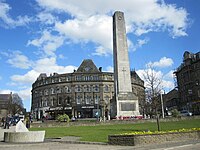 Harrogate is also a popular tourist destination, famous for its Turkish Baths, gastronomy and high-end shops. The picture is of Victoria Gardens Shopping Centre.
Harrogate is also a popular tourist destination, famous for its Turkish Baths, gastronomy and high-end shops. The picture is of Victoria Gardens Shopping Centre. -
 Roseberry Topping in the North York Moors
Roseberry Topping in the North York Moors -
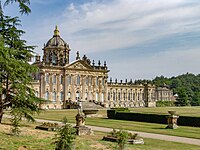
Religious sites

-
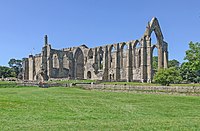
-
 In terms of interior floor area, York Minster is the 3rd Largest Cathedral in the United Kingdom.
In terms of interior floor area, York Minster is the 3rd Largest Cathedral in the United Kingdom. -
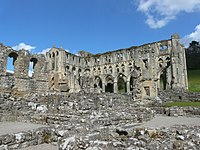
-
 With the first monastery built in the 7th century, the ruins of the medieval Whitby Abbey still stand today, now famous for its role in Dracula.
With the first monastery built in the 7th century, the ruins of the medieval Whitby Abbey still stand today, now famous for its role in Dracula.
Seaside


|
News and media
The county is served by BBC Yorkshire and BBC North East and Cumbria. Along the county's coast, Scarborough and Filey receive BBC Yorkshire and Whitby receives BBC North East and Cumbria.
ITV Yorkshire and ITV Tyne Tees are also received in most areas of the county, Settle and furthest western part of the county is served by BBC North West and ITV Granada. BBC Radio Tees is broadcast to northern parts of the county, whilst BBC Radio York is broadcast to the entire county.
Sport
Cricket
Yorkshire County Cricket Club play a number of fixtures at North Marine Road, Scarborough and some 2nd XI games in Richmond. The ball game Rock-It-Ball was developed in the county.
Association football

North Yorkshire has a number of association football clubs, including:
Middlesbrough are currently the highest-ranked team in the county as they play in the EFL Championship. In the past, they have won the EFL Cup and reached the UEFA Cup final. Harrogate Town play in the EFL League Two. York City play in the National League. Scarborough Athletic, a phoenix club of Scarborough, play in the National League North. Whitby Town have reached the FA Cup first round seven times and have played the likes of Hull City, Wigan Athletic and Plymouth Argyle; they currently play in the Northern Premier League Premier Division.
Rugby football

| League | Team | Venue | Capacity | Location |
|---|---|---|---|---|
| National League 2 North | Harrogate | Rudding Lane | Harrogate | |
| Wharfedale | The Avenue | 2,000 | Threshfield | |
| Regional 1 North East | York | Clifton Park | York, North Yorkshire | |
| Regional 2 North East | Malton & Norton | The Gannock | Malton | |
| Scarborough | Silver Royd | 4,500 (425 seats) | Scalby, Scarborough | |
| Selby | Sandhill Lane | Selby | ||
| Regional 2 North | Middlesbrough | Acklam Park | 5,000 (159 seats) | Acklam, Middlesbrough |
The leading rugby union teams in the county include Wharfedale RUFC, Harrogate RUFC, but teams also include Middlesbrough RUFC and Acklam RUFC who play their league games in Regional 2 North, a corresponding league of the same level hosting teams from Teesside, County Durham and Northumberland. The rugby league club, York RLFC, are represented by York Knights who play in the Rugby League Championships and York Valkyrie in the RFL Women's Super League.
Racing
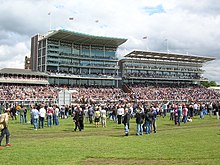
North Yorkshire has multiple racecourses, at: Catterick Bridge, Redcar, Ripon, Thirsk and York. It also has one motor racing circuit, Croft Circuit; the circuit holds meetings of the British Touring Car Championship, British Superbike and Pickup Truck Racing race series and one Motorcycle Racing Circuit at Oliver's Mount, Scarborough.



